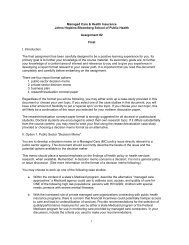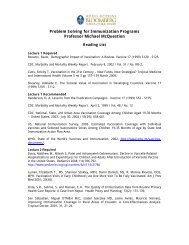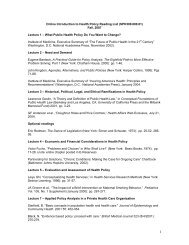Epidemiologic Investigations - jhsph ocw - Johns Hopkins ...
Epidemiologic Investigations - jhsph ocw - Johns Hopkins ...
Epidemiologic Investigations - jhsph ocw - Johns Hopkins ...
Create successful ePaper yourself
Turn your PDF publications into a flip-book with our unique Google optimized e-Paper software.
This work is licensed under a Creative Commons Attribution-NonCommercial-ShareAlike License. Your use of this<br />
material constitutes acceptance of that license and the conditions of use of materials on this site.<br />
Copyright 2008, The <strong>Johns</strong> <strong>Hopkins</strong> University and Sukon Kanchanaraksa. All rights reserved. Use of these<br />
materials permitted only in accordance with license rights granted. Materials provided “AS IS”; no representations or<br />
warranties provided. User assumes all responsibility for use, and all liability related thereto, and must independently<br />
review all materials for accuracy and efficacy. May contain materials owned by others. User is responsible for<br />
obtaining permissions for use from third parties as needed.
<strong>Epidemiologic</strong> Investigation<br />
Sukon Kanchanaraksa, PhD<br />
<strong>Johns</strong> <strong>Hopkins</strong> University
Section A<br />
Objectives of Epidemiology
Insatiable Curiosity<br />
Source: “The Elephant’s Child” in Just So Stories by Rudyard Kipling<br />
Photo source: http://www.online-literature.com/kipling. Public Domain<br />
I Keep six honest serving-men:<br />
(They taught me all I knew)<br />
Their names are What and Where and When<br />
And How and Why and Who.<br />
— Rudyard Kipling (1865–1936)<br />
4
Epidemiology as a Science and a Method<br />
Epi = upon, among<br />
Demos = people<br />
Ology = science, study of<br />
Epidemiology = the science or the study of epidemic<br />
− It is the scientific method of disease investigation<br />
− Typically, it involves the disciplines of biostatistics and<br />
medicine<br />
5
John Snow (1813–1858)<br />
An English physician and modern-day father of epidemiology<br />
He used scientific methods to identify the cause of the<br />
epidemic of cholera in London in 1854<br />
He believed that it was the water pump on Broad Street that<br />
was responsible for the disease<br />
− The removal of the pump handle ended the outbreak<br />
Photo source of two color images: Sukon Kanchanaraksa<br />
Photo source of portrait: http://www.ph.ucla.edu/epi/snow/fatherofepidemiology.html. Public Domain<br />
6
A Definition of Epidemiology<br />
The study of distribution and determinants of health,<br />
disease, or injury in human populations and the application<br />
of this study to the control of health problems<br />
7
Types of Epidemiology<br />
Distribution<br />
−<br />
−<br />
Frequency of health events<br />
By person, time and place<br />
Determinants<br />
− Search for causes or risk factors<br />
− Response to a study hypothesis<br />
Use various epidemiologic methods<br />
−<br />
Descriptive<br />
epidemiology<br />
Analytic<br />
epidemiology<br />
8
Types of Epidemiology<br />
− Frequency of health events<br />
− By person, time and place<br />
Descriptive<br />
epidemiology<br />
Determinants<br />
− Search for causes or risk factors<br />
− Response to a study hypothesis<br />
− Use various epidemiologic methods<br />
Analytic<br />
epidemiology<br />
Health, disease, or injury<br />
− All health outcomes<br />
Disease-specific<br />
epidemiology<br />
Application<br />
Applied epidemiology<br />
Distribution<br />
9
Objectives of Epidemiology<br />
Investigate the etiology of disease and modes of transmission<br />
Determine the extent of disease problems in the community<br />
Study the natural history and prognosis of disease<br />
Evaluate both existing and new preventive and therapeutic<br />
measures and modes of health care delivery<br />
Provide a foundation for developing public policy and<br />
regulatory decisions<br />
Source: Gordis, Epidemiology, 2004.<br />
10
U.S. Mortality, 2001<br />
Rank Cause of Death<br />
No. of<br />
Death<br />
% of all<br />
Deaths<br />
1 Heart Diseases 700,142 29.0<br />
2 Cancer 553,768 22.9<br />
3 Cerebrovascular diseases 163,538 6.8<br />
4 Chronic lower respiratory diseases 123,013 5.1<br />
5 Accidents (Unintentional injuries) 101,537 4.2<br />
6 Diabetes mellitus 71,372 3.0<br />
7 Influenza and Pneumonia 62,034 2.6<br />
8 Alzheimer’s disease 53,852 2.2<br />
9 Nephritis 39,480 1.6<br />
10 Septicemia 32,238 1.3<br />
Source: US Mortality Public Use Data Tape 2001, National Center for Health Statistics, Centers for Disease<br />
Control and Prevention, 2003.<br />
11
Estimated U.S. Cancer Deaths, 2004<br />
Lung and bronchus<br />
Prostate<br />
Colon and rectum<br />
Pancreas<br />
Leukemia<br />
Non-Hodgkin<br />
lymphoma<br />
Esophagus<br />
Liver and intrahepatic<br />
bile duct<br />
Urinary bladder<br />
Kidney<br />
All other sites<br />
32%<br />
10%<br />
10%<br />
5%<br />
5%<br />
4%<br />
4%<br />
3%<br />
3%<br />
3%<br />
21%<br />
Source: American Cancer Society, 2004<br />
Men<br />
290,890<br />
Women<br />
272,810<br />
25%<br />
15%<br />
10%<br />
6%<br />
6%<br />
4%<br />
3%<br />
3%<br />
2%<br />
2%<br />
24%<br />
Lung and bronchus<br />
Breast<br />
Colon and rectum<br />
Ovary<br />
Pancreas<br />
Leukemia<br />
Non-Hodgkin lymphoma<br />
Uterine corpus<br />
Multiple myeloma<br />
Brain/ONS<br />
All other sites<br />
ONS=Other nervous system<br />
12
Trends in Obesity<br />
Prevalence (%)<br />
45<br />
40<br />
35<br />
30<br />
25<br />
20<br />
15<br />
10<br />
5<br />
0<br />
Prevalence (%) of Obesity in Adults Aged 20 to 74<br />
by Gender, U.S. 1960–2000<br />
13<br />
15<br />
15<br />
23<br />
31<br />
11<br />
12<br />
*Obesity is defined as a body mass index of 30 kg/m 2 or greater.<br />
13<br />
Both sexes Men Women<br />
NHES I (1960-62) NHANES I (1971-74) NHANES II (1976-80) NHANES III (1988-94) NHANES 1999-2000<br />
Source: National Health Examination Survey 1960-1962, National Health and Nutrition Examination Survey, 1971-1974, 1976-1980, 1988-1994, 1999-2000,<br />
National Center for Health Statistics, Centers for Disease Control and Prevention, 2002.<br />
21<br />
28<br />
16<br />
17<br />
17<br />
26<br />
34<br />
13
What Is it? (Prion, Virus, Bacteria)<br />
Prion: http://en.wikipedia.org/wiki/Image:Prion.gif. Public Domain.<br />
HIV: http://commons.wikimedia.org/wiki/Image:800px-HIV_Viron.png. Public Domain.<br />
"Bacterial Cell Structure" from Epidemiology of Infectious Diseases. Available at: http://<strong>ocw</strong>.<strong>jhsph</strong>.edu. Copyright<br />
© <strong>Johns</strong> <strong>Hopkins</strong> Bloomberg School of Public Health. Creative Commons BY-NC-SA.<br />
14
Mysterious Virus in the Four Corners Region of U.S.<br />
An outbreak of sudden<br />
respiratory illness occurred in<br />
the Four Corners region of the<br />
southwestern U.S. in 1993<br />
In similar outbreaks in 1918<br />
and 1936, there was an<br />
increase in the number of mice<br />
in the region due to the abundance<br />
of pi-on nuts (food for rodents) brought on by increased<br />
rainfall<br />
<strong>Epidemiologic</strong> study confirmed the connection between<br />
rodents and households with sick occupants<br />
http://www.amnh.org/exhibitions/epidemic/section_02/sectwo_pg_02.html<br />
http://www.cdc.gov/ncidod/diseases/hanta/hps/noframes/generalinfoindex.htm<br />
Wood Mouse by Andy Field. Creative Commons BY-NC-SA.<br />
15
Mysterious Virus in the Four Corners Region of U.S.<br />
Hanta virus was discovered<br />
in rodents that excreted<br />
the virus in their feces and<br />
urine<br />
People inhaled the dust<br />
particles that contained the<br />
virus and became ill<br />
(hantavirus pulmonary syndrome)<br />
To prevent the spread of the virus:<br />
−<br />
−<br />
−<br />
Mice-proof the home<br />
Wear a mask while sweeping in the home<br />
Wash the floor with an antiseptic solution<br />
http://www.amnh.org/exhibitions/epidemic/section_02/sectwo_pg_02.html<br />
http://www.cdc.gov/ncidod/diseases/hanta/hps/noframes/generalinfoindex.htm<br />
Wood Mouse by Andy Field. Creative Commons BY-NC-SA.<br />
16
Epidemiology and Radon<br />
Lung Cancer Mortality<br />
Colorado Plateau Uranium Miners<br />
Follow-up Date<br />
1959<br />
1962<br />
1967<br />
1974<br />
1977<br />
Mortality Relative Risk<br />
2.0<br />
3.6<br />
6.2<br />
4.8<br />
4.8<br />
17
Epidemiology and Radon as Treatment<br />
“ … patients seeking a<br />
natural arthritis cure visit<br />
modern radon therapy clinics<br />
and underground galleries for<br />
the sole purpose of radon<br />
inhalation or radon balneology”<br />
“Clinical, double-blind and<br />
randomized controlled studies<br />
in those countries report findings<br />
substantiating claims of pain and symptom relief, supporting<br />
the observations of benefit equal to that reported by visitors<br />
to the Free Enterprise Radon Health Mine located at Boulder,<br />
Montana”<br />
http://www.radonmine.com/why.html<br />
18
Epidemiology and Polio Vaccine<br />
The year 2005 commemorated the 50th<br />
anniversary of the announcement that the<br />
Salk polio vaccine was effective<br />
In April, 1955, Dr. Thomas Francis, director<br />
of Poliomyelitis Vaccine Evaluation Center<br />
at the University of Michigan, announced<br />
that the two-year field trial of the Salk<br />
vaccine against polio was up to 90%<br />
effective<br />
“The results announced by Francis<br />
effectively marked the beginning of the<br />
end of polio as the most life-threatening<br />
and debilitating public health threat to the<br />
children of the United States“<br />
http://www.umich.edu/%7Ebhl/bhl/digpubs/polio/guideintro.htm<br />
http://www.med.umich.edu/medschool/chm/polioexhibit/salk_report.htm<br />
http://www.med.umich.edu/medschool/chm/polioexhibit/press_release.htm<br />
Image: http://en.wikipedia.org/wiki/Image:Iron_Lung_ward-Rancho_Los_Amigos_Hospital.gif. Public Domain.<br />
19
Uses of Epidemiology<br />
In historical study of health and diseases in the population<br />
and in projecting into the future<br />
For community diagnosis of the presence, nature and<br />
distribution of health and diseases among the population<br />
To study the working of health services<br />
To estimate the individual’s chances and risks of disease<br />
To help complete the clinical picture of diseases<br />
In identifying syndromes from the distribution of clinical<br />
phenomena among sections of the population<br />
In the search for causes of health and disease<br />
Source: Morris, JN. Uses of Epidemiology. 1957.<br />
20
Review Questions<br />
What is epidemiology?<br />
Choose a disease that is of interest to you<br />
− Describe the disease by time, place, and person<br />
21
Section B<br />
Dynamics of Disease Transmission
Describing a Disease: <strong>Epidemiologic</strong> Triad<br />
Host<br />
Vector<br />
Agent Environment<br />
23
Factors Associated with Increased Risk of Human Disease<br />
HOST (Intrinsic)<br />
Age<br />
Gender<br />
Ethnicity<br />
Religion<br />
Customs<br />
Occupation<br />
Heredity<br />
Marital status<br />
Family<br />
background<br />
Previous<br />
diseases<br />
AGENTS<br />
Biological<br />
(bacteria, etc.)<br />
Chemical<br />
(poison,<br />
alcohol,<br />
smoke)<br />
Physical (auto,<br />
radiation, fire)<br />
Nutritional<br />
(lack, excess)<br />
ENVIRONMENT<br />
(Extrinsic)<br />
Temperature<br />
Humidity<br />
Altitude<br />
Crowding<br />
Housing<br />
Neighborhood<br />
Water<br />
Milk<br />
Food<br />
Radiation<br />
Air pollution<br />
Noise<br />
24
Dynamics of Disease Transmission<br />
Interaction of agents and environmental factors with human<br />
hosts<br />
Distribution of severity of disease<br />
Modes of disease transmission<br />
Level of disease in a community when transmission stops<br />
25
The “Iceberg”<br />
Concept of Infectious Diseases<br />
(At the level of the cell and of the host )<br />
Source: Evans, 1991<br />
Cell response<br />
Lysis of cell<br />
Inclusion body formation<br />
or<br />
Cell transformation<br />
or<br />
Cell dysfunction<br />
Viral multiplication<br />
Without visible change<br />
or incomplete<br />
Viral maturation<br />
Exposure without<br />
attachment and/or<br />
cell entry<br />
Host response<br />
Death of organism<br />
Classical and severe<br />
disease<br />
Moderate severity<br />
Mild illness<br />
Infection without<br />
Clinical illness<br />
(asymptomatic<br />
infection)<br />
Exposure<br />
without<br />
infection<br />
26
Distribution of Clinical Severity for Three Infections<br />
(not drawn to scale)<br />
Class A: unapparent infection frequent<br />
Example: tubercle bacillus<br />
0 Percentage of infections<br />
100<br />
Class B: clinical disease frequent; few deaths<br />
Example: measles virus<br />
0 Percentage of infections<br />
100<br />
Class C: infections usually fatal<br />
Example: rabies virus<br />
0 100<br />
Unapparent<br />
Mild<br />
Source: Mausner and Kramer, 1985 p.265<br />
Moderate Severe (nonfatal) Fatal<br />
27
Unapparent Infection<br />
Preclinical disease: in the early stage of disease progression,<br />
disease is not clinically detected but is destined to become<br />
clinical disease<br />
Subclinical disease: disease is not detected but the host<br />
carries the organism or has antibody response.<br />
Source: http://www.pbs.org/wgbh/nova/typhoid/<br />
A well known example is the typhoid<br />
disease outbreaks in New York City in the<br />
early 1900s. Typhoid Mary (Mary Mallon)<br />
was a healthy carrier of Salmonella typhi;<br />
she continued to work as a cook and<br />
infected numerous people until she was<br />
quarantined for life against her will.<br />
28
Pathway of Disease Infection<br />
Infected host<br />
(or reservoir)<br />
Portal of exit<br />
Modes of transmission<br />
Portal of entry<br />
Susceptible host<br />
29
Portals of Exit and Entry<br />
Mims CA, Dimmock NJ, Nash A, et al. Mims’ Pathogenesis of Infectious Disease, ed 4. London, 1995. p. 10<br />
30
Transmission of Agents<br />
Direct contact (person-to-person)<br />
− Skin, saliva via kissing, sexual contact,<br />
aerosol from sneezing or coughing<br />
− Polio, hepatitis, HIV, influenza<br />
Indirect contact<br />
− Via vector (an organism that carries disease-causing micro-organisms,<br />
such as mosquito), dust particles, air, food, water, blood, tissues,<br />
organs, fomites (inanimate objects that can carry disease-causing<br />
micro-organisms—e.g., toothbrush, cutting board, toys, etc. )<br />
− Diseases that are commonly spread by means of fomites include the<br />
common cold, cold sores, conjunctivitis, coxsackievirus (hand-footmouth<br />
disease), croup, E. coli infection, Giardia infection, influenza,<br />
lice, meningitis, rotavirus diarrhea, RSV, and strep<br />
Source: http://tos.beastlet.com/gallerym3.html<br />
31
Transmission of Agents from Mother to Child<br />
Vertical transmission (inter-generation) is the transmission<br />
of disease-causing agents from mother directly to baby<br />
− Just before or just after birth<br />
− Via placenta or breast milk<br />
Horizontal transmission: all other transmissions<br />
Diseases that can be transmitted from mother to baby<br />
include:<br />
− HIV<br />
Hepatitis C<br />
−<br />
32
SARS (Severe Acute Respiratory Syndrome)<br />
Spreads by direct contact (person to person) from droplets<br />
from cough or sneeze (short distance)<br />
Droplets enter via the mucous membranes of the mouth,<br />
nose, or eyes<br />
Can also spread by indirect contact when the person touches<br />
contaminated objects and then touches his or her mouth,<br />
nose, or eyes<br />
http://www.cdc.gov/niosh/topics/SARS/. Public Domain.<br />
33
Frequency of Exposure in Indirect Contact<br />
Single<br />
Exposure<br />
Multiple<br />
Exposure<br />
Common vehicle<br />
single exposure<br />
Continuous<br />
Exposure<br />
34
Common Vehicle Single Exposure<br />
Group of individuals exposed to a common vehicle (food,<br />
water, air, etc.)<br />
The exposure was one time (for example, the food was served<br />
only once)<br />
Typical characteristic<br />
Explosive (abrupt) increase in the number of diseased<br />
individuals and then the number declines gradually over<br />
time<br />
Examples: food-borne outbreak at school, church, or on a<br />
cruise ship<br />
35
Quick Check: SARS Virus<br />
SARS virus is known to be transmitted via aerosol spread from<br />
coughing. On March 15, 2003, a Boeing 737-300 carrying 120<br />
persons flew for three hours from Hong Kong to Beijing. An<br />
individual with SARS was on board. Eighteen people were<br />
believed to contract the disease on the flight.<br />
Was this a common vehicle single exposure outbreak?<br />
36
Definition of Endemic, Epidemic, and Pandemic<br />
Endemic<br />
−<br />
−<br />
The habitual presence of a disease within a<br />
given geographic area<br />
May also refer to the usual prevalence of a<br />
given disease within such an area (APHA)<br />
Epidemic<br />
− The occurrence in a community or region of a<br />
group of illnesses of similar nature, clearly in<br />
−<br />
excess of normal expectancy (APHA)<br />
Outbreak<br />
Pandemic<br />
− A worldwide epidemic<br />
Endemic Epidemic<br />
Time<br />
37
London Smog Disaster, 1952<br />
Air pollution causes respiratory illnesses and death<br />
When fog and soot from coal burning created a dense<br />
smog in Winter, 1952, in London, the smog was around for<br />
five days fromDecember 5–10, 1952<br />
There was a substantial increase in mortality<br />
−<br />
Estimated premature death of 12,000<br />
The death rate in London in the previous week was around<br />
2,062<br />
− In the week of the smog, 4,703 died<br />
Source: NPR, http://www.npr.org/templates/story/story.php?storyId=873954<br />
AP<br />
38
Deaths in Greater London Each Day<br />
From December 1–15, 1952<br />
"1952 London Fog. High levels of pollution correspond to a similar pattern in daily mortality." from Biostatistics<br />
Lecture Series . Available at: http://<strong>ocw</strong>.<strong>jhsph</strong>.edu. Copyright © <strong>Johns</strong> <strong>Hopkins</strong> Bloomberg School of Public<br />
Health. Creative Commons BY-NC-SA.<br />
39
Herd Immunity and Disease Transmission<br />
In a population, disease transmission may stop before all<br />
susceptible individuals are infected<br />
Herd immunity is the resistance of a group to attack from a<br />
disease to which a large portion of members are immune,<br />
thus lessening the likelihood of a patient with a disease<br />
coming into contact with a susceptible individual<br />
Immune<br />
Susceptible<br />
Diseased<br />
40
Some Requirements of Herd Immunity<br />
The disease agent is restricted to a single-host species within<br />
which transmission occurs<br />
− For example, smallpox in human; no reservoir<br />
There is relatively direct transmission from one member of<br />
the host species to another (direct contact only)<br />
Infections must induce solid immunity (also from<br />
immunization)<br />
41
Herd Immunity and Disease Control<br />
The success of herd immunity in controlling the disease<br />
depends on the proportion of subjects with immunity in a<br />
population<br />
− Immunity can be from immunization or infection<br />
So, when the population is immunized (e.g. ,vaccinated) at or<br />
above the herd immunity level (critical immunization<br />
threshold), the infectious disease will not spread and will be<br />
eliminated<br />
Herd immunity level differs for various diseases<br />
− For example, it is estimated that 94% of the population<br />
must be immune before measles can be controlled<br />
−<br />
−<br />
For mumps, it is around 90%<br />
The more infectious the disease is, the higher the herd<br />
immunity level<br />
42
Review<br />
What is the epidemiologic triad of disease transmission?<br />
How is preclinical disease different from subclinical disease?<br />
Distinguish direct from indirect contact<br />
Distinguish horizontal from vertical disease transmission<br />
Explain the iceberg concept of disease transmission<br />
Distinguish endemic, epidemic, and pandemic diseases from<br />
each other<br />
What is the concept of herd immunity in disease<br />
transmission?<br />
43
Section D<br />
Investigation of an Outbreak
Importance of Outbreak Investigation<br />
Stop the current outbreak from spreading<br />
Prevent future similar outbreaks<br />
Provide scientific explanation of the event<br />
Provide knowledge for the understanding of the disease<br />
process<br />
React to and calm public and political concerns<br />
Train epidemiologists<br />
45
Investigating an Outbreak<br />
Define what will be studied<br />
Find out where the problem is<br />
− Who gets it<br />
When it is occurring<br />
−<br />
I Keep six honest serving-men:<br />
(They taught me all I knew)<br />
Their names are What and Where and When<br />
And How and Why and Who.<br />
Try to explain why the problem has such a distribution<br />
Do specific studies to find out how the problem is occurring<br />
Source: “The Elephant’s Child” in Just So Stories by Rudyard Kipling<br />
Photo source: http://www.online-literature.com/kipling. Public Domain<br />
— Rudyard Kipling (1865–1936)<br />
46
Common Steps in the <strong>Epidemiologic</strong> Approach<br />
The steps in the epidemiologic approach to study a problem<br />
of disease etiology are:<br />
− Perform an initial observation to confirm the outbreak<br />
− Define the disease<br />
− Describe the disease by time, place, and person<br />
− Create a hypothesis as to the possible etiologic factors<br />
− Conduct analytic studies<br />
− Summarize the findings<br />
− Recommend and communicate the interventions or<br />
preventative programs<br />
47
Steps<br />
Conduct field work<br />
− Perform initial observation<br />
− Establish the existence of an outbreak<br />
− Verify diagnosis<br />
− Collect data<br />
Define disease<br />
− Establish case definition<br />
− Identify all cases<br />
− Identify the population at risk<br />
Describe disease by time, place, and person<br />
− Plot epidemic curve<br />
− Plot spot map<br />
Tabulate data of exposure and other characteristics<br />
−<br />
48
Steps<br />
Develop hypothesis<br />
− Hypothesis: exposure to X is associated with disease Y<br />
Conduct analytic studies<br />
− Use appropriate analytic studies<br />
− Calculate measures of risk<br />
− Refine hypothesis<br />
− Conduct additional studies if needed<br />
Summarize findings<br />
Recommend and communicate interventions or preventative<br />
programs<br />
49
Exercise<br />
“Foodborne Outbreak Following a Charity Luncheon”<br />
−<br />
−<br />
−<br />
−<br />
−<br />
−<br />
−<br />
(Initial observation has been conducted)<br />
Line listing of data in Excel<br />
Summary data from Stata<br />
Define disease and population at risk<br />
Describe disease (by time, place, and person), plot<br />
epidemic curves<br />
Develop hypothesis<br />
Analyze data (test hypothesis) by calculating attack rates<br />
and comparing attack rates in various subgroups<br />
Summarize findings<br />
Recommend interventions and preventative programs<br />
50
Submit A Case Study<br />
The instructors of this course are using WikiEducator to<br />
collect case studies to illustrate different types of<br />
epidemiologic investigations.<br />
The instructors are particularly interested in studies<br />
conducted in Western Asia and the Arabian Peninsula, and<br />
they are looking to OCW users to help them find the best<br />
examples.<br />
Click here to visit WikiEducator and submit a case study by<br />
editing the wiki page.<br />
− Registration is required to submit a case study.<br />
51
















